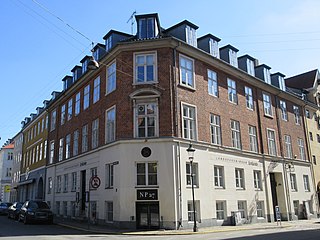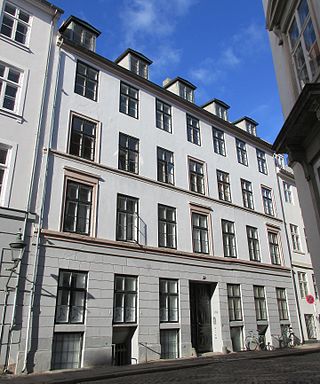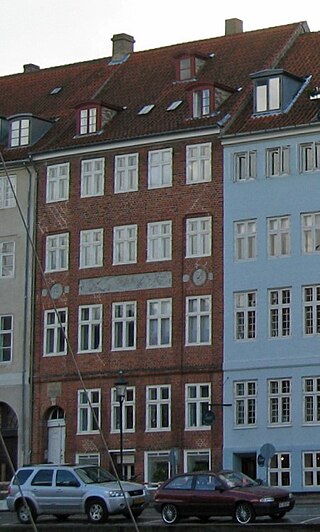Events from the year 1774 in Denmark.

The Prince's Mansion is a palatial Rococo-style mansion located at Frederiksholms Kanal in central Copenhagen, Denmark. It used to serve as the official residence of the Crown Prince of Denmark but now houses the National Museum of Denmark.

Barchmann Mansion is a Baroque style town mansion overlooking Frederiksholm Canal in central Copenhagen, Denmark. Built in the early 1740s to designs by Philip de Lange, it is also known as the Wedell Mansion after the current owner. It was listed in the Danish registry of protected buildings and places in 1918. An extension from 1748 is now home to Johan Borup's Folk High School.

Ny Kongensgade is a street in central Copenhagen, Denmark, connecting Frederiksholm Canal to H. C. Andersens Boulevard. In the opposite direction, The Prince's Bridge connects the street to Tøjhusgade on Slotsholmen.

Stormgade is a street in central Copenhagen, Denmark. It runs from Frederiksholm Canal to H. C. Andersens Boulevard where it turns into Tietgensgade before continuing along the rear side of Tivoli Gardens and Copenhagen Central Station. In the opposite direction, Storm Bridge connects it to Slotsholmen where traffic may continue across Holmen's Bridge to Holmens Kanal, part of Ring 2, or across Knippel's Bridge to Christianshavn and Amager. The name of the street refers to the Swedish Storm of Copenhagen in 1659.

Hotel Phoenix Copenhagen is a hotel located at the corner of Bredgade and Dronningens Tværgade in Copenhagen, Denmark. The first Hotel Phoenix opened at the site in 1848 but closed when it was confiscated by the Germans during World War II. The building was after the war converted into a new headquarters for the Danish Communist Party and the newspaper Land og Folk. The building was acquired by Arp-Hansen Hotel Group in 1990 and reopened as a hotel the following year.. It is mentioned in Jules Verne's Journey to the Center of the Earth,

Frederiksholms Kanal 16–18 are two almost identical listed properties overlooking Frederiksholm Canal in central Copenhagen, Denmark. The Victorian Home, a 15-room, late 19th-century bourgeois home now operated as a historic house museum by the National Museum of Denmark, is located on the second floor of No. 18. The Attorney general (Rigsadvokaten) is based at No. 16. Both buildings were listed on the Danish registry of protected buildings and places by the Danish Heritage Agency on 6 April 1969.

Frederiksholms Kanal 20, located at the corner with Ny Kongensgade, is a mid-19th century apartment building overlooking Frederiksholms Kanal in central Copenhagen, Denmark. Its current appearance dates from 1848 when a building from before 1750 was heightened with two floors. The neighbouring building at Ny Kongensgade 4 and a three-storey warehouse in the courtyard were also built at this point. All three buildings were listed on the Danish registry of protected buildings and places in 1959.

Ny Kongensgade 7 is a historic property in the small Frederiksholm Quarter of central Copenhagen, Denmark. It was listed on the Danish registry of protected buildings and places on 31 March 1931.

Ny Kongensgade 111 is a listed 19th century property in the Frederiksholm Quarter of central Copenhagen, Denmark. It was listed on the Danish registry of protected buildings and places in 1976.

The Dehn Mansion is one of two identical but mirror-imag Rococo-style town mansions on Bredgade, flanking the entrance to Amalienborg via Frederiksgade, in the Frederiksstaden district of Copenhagen, Denmark. It takes its name after Friedrich Ludwig von Dehn, its first owner. The mansion was later divided into two separate properties. The larger, northn part of the mansion is now owned by the Danish Association of Pharmaconomists. The southern part is owned by Karberghus. The building was listed in the Danish registry of protected buildings and places in 1918.

John Brown was a Scottish-Danish merchant and ship-owner. He was a joint founder of John & David Brown in 1759. The company owned 17 ships in 1787 but was liquidated the following year. He was also active in the Danish Asiatic Company where he was a member of the board of directors from 1770–75 and from 1779–85. He was appointed as General War Commissioner in 1776. He was the second-largest landowner in Gentofte and owned Benzonseje from 1784 to 1788.

Rågegården is an Arts & Crafts inspired country house from 1915 situated on the eastern outskirts of Rågeleje, Gribskov Municipality, some fifty kilometres northwest of Copenhagen, Denmark. The house is perched on a small wooded hill, overlooking the Kattegat coast. It was listed on the Danish registry of protected buildings and places in 1989. The scope of the heritage listing was expanded in 2012.

Stormgade 8 is a three-storey, 18th century property situated at Stormgade 8 in Copenhagen, Denmark. The buildingwas listed in the Danish registry of protected buildings and places in 1918.

Ny Kongensgade 5 is an 18th-century property located in the small Frederiksholm Neighborhood of central Copenhagen, Denmark. The building shares a small courtyard with Ny Kongensgade 7. It was listed in the Danish registry of protected buildings and places in 1950.

Brøndumgård is a Neoclassical town mansion from 1804 situated at Store Kongensgade 110 in central Copenhagen, Denmark. It was listed in the Danish registry of protected buildings and places in 1918. Changing breweries or distilleries were from the beginning of the 18th century until 1918 operated on the rear of the property. It was from 1842 owned by Anders Brøndum for whom two rear wings, neither of which are listed, were constructed in the 1850s. The entire complex was converted into condominiums in 2007–10.

John Christmas was an English-born Danish sea captain and general trader. Christmas was born in Bideford, and emigrated to Denmark in 1790. He became a merchant and businessman in Copenhagen. He was the father of naval officer and plantation owner on Saint Croix in the Danish West Indies, John Christmas.

Nikolaj Plads 27 is a Neoclassical property situated at the corner of Nikolaj Plads and Admiralgade in central Copenhagen, Denmark. It was like most of the other buildings in the area constructed as part of the rebuilding of the city following the Copenhagen Fire of 1795. It was listed in the Danish registry of protected buildings and places es in 1945.

Admiralgade 22 is a Neoclassical apartment building situated close to Nikolaj Plads in Copenhagen, Denmark. It was constructed in 1845–46 for a wholesale merchant named Harboe for whom Ved Stranden 16 on the other side of the block was also heightened by one storey. The two buildings was at the same time divided into two separate properties. Admiralgade 22 was listed in the Danish registry of protected buildings and places in 1959. The scope of the heritage listing was extended in 1988. Notable former residents include the ballet dancer Adolph Stramboe.

Nyhavn 8 is an 18th-century property overlooking the Nyhavn canal i central Copenhagen, Denmark. It was listed in the Danish registry of protected buildings and places in 1918. A sandstone tablet with inscription above the arched main entrance commemorates a time when Dragør skippers used to stay in the building during the winter months.





















